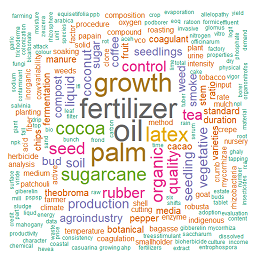Produktivitas Kopi Arabika (Coffea arabica Linden.) pada Penaung Berbeda di Hutan Lindung Desa Sukalaksana Kabupaten Garut
DOI:
https://doi.org/10.25181/jaip.v12i2.3487Keywords:
agroforestry, branch-free, bole height, coffee farmersAbstract
The protected forest area managed by Perum Perhutani in Sukalaksana village is dominated by pine trees (Pinus merkusii) and rasamala trees (Altingia excelsa). Coffee farmers in Sukalaksana village grow arabica coffee using an agroforestry system under pine and rasamala stands within the framework of joint forest management. So that the arabica coffee commodity can have optimal economic value, coffee farmers in Sukalaksana village need to observe the productivity of arabica coffee plants. The research location is in the protected forest area of Sukalaksana village, Talegong district, Garut Regency. The object of observation was the soil in coffee plantations, Timtim varieties of arabica coffee plants, planted using an agroforestry system with rasamala trees and pine trees as shade. Data were analyzed descriptively using an uncorrelated t-test and linear regression analysis. Descriptively, there is no difference in the fertility level of coffee planting soil on land shaded by rasamala and land shaded by pine. The productivity of coffee plants under the rasamala shade is higher than that of coffee plants under the pine shade. This is caused by significant differences in the branch-free bole height of shade trees. The rasamala shade has its first crown branch, which is higher than the pine shade.Downloads
References
Alvarez-Alvarez, E., Almazán-Núñez, R., González-García, F., Brito-Millán, M., Méndez Bahena, A., & García-Ibáñez, S. (2021). Shade coffee plantations maintain woody plant diversity and structure in a cloud forest landscape of southern Mexico. Journal of Forestry Research, 32, 637–648. https://doi.org/10.1007/s11676-020-01143-5
Assa, A., Loppies, J. E., Amalia, A. N., Indriana, D., Mamang, Utami, R. R., Ariyanti, M., & Winaldi, A. (2021). Chemical compounds and sensory characteristics of Arabica coffee (Coffea arabica) as a novel specialty coffee from Sinjai Regency, Indonesia. Food Research, 5(S2), 107–112. https://doi.org/10.26656/fr.2017.5(S2).001
Azhar, I., Rahmawaty, R., Saraan, M., Taufik, M., Muamar, Aulin, F., Situmeang, D., & Barus, K. (2021). Marketing analysis and feasibility analysis of coffee (Coffea sp.). IOP Conference Series: Earth and Environmental Science, 782, 022033. https://doi.org/10.1088/1755-1315/782/2/022033
Bosso, H., Barbalho, S., Goulart, R., & Otoboni, A. (2021). Green coffee: Economic relevance and a systematic review of the effects on human health. Critical Reviews in Food Science and Nutrition, 63, 1–17. https://doi.org/10.1080/10408398.2021.1948817
Damayanti, N. L. P. S. D., Udayana, I. G. B., & Situmeang, Y. P. (2022). Arabica Coffee Plant Response to Atonic Concentration and Production Pruning. SEAS (Sustainable Environment Agricultural Science), 6(1), 10–15. https://doi.org/10.22225/seas.6.1.4881.10-15
Durand-Bessart, C., Tixier, P., Quinteros, A., Andreotti, F., Rapidel, B., Tauvel, C., & Allinne, C. (2020). Analysis of interactions amongst shade trees, coffee foliar diseases and coffee yield in multistrata agroforestry systems. Crop Protection, 133, 105137. https://doi.org/10.1016/j.cropro.2020.105137
Etafa, A. T. (2022). Effect of dominant shade tree species on selected soil physicochemical properties and coffee production in Sayyo district, western Ethiopia. Trees, Forests and People, 8, 100245. https://doi.org/10.1016/j.tfp.2022.100245
Getachew, M., Verheyen, K., Tolassa, K., Tack, A. J. M., Hylander, K., Ayalew, B., Boeckx, P., Landuyt, D., & De Frenne, P. (2023). Effects of shade tree species on soil biogeochemistry and coffee bean quality in plantation coffee. Agriculture, Ecosystems & Environment, 347, 108354. https://doi.org/10.1016/j.agee.2023.108354
Karim, A., Hifnalisa, H., & Manfarizah, M. (2021). Analysis of arabica coffee productivity due to shading, pruning, and coffee pulp-husk organic fertilizers treatments. Coffee Science, 16, 1–8. https://doi.org/10.25186/.v16i.1903
Lara-Estrada, L., Rasche, L., & Schneider, U. (2023). Exploring the cooling effect of shading for climate change adaptation in coffee areas. Climate Risk Management, 42, 100562. https://doi.org/10.1016/j.crm.2023.100562
Marbun, P., Nasution, Z., Hanum, H., & Karim, A. (2020). The classification, characteristics, and assessment of soil profile fertility on Coffea arabica productivity in North Sumatra. Bulg. J. Agric. Sci, 26(3), 622–632.
Piato, K., Subía, C., Pico, J., Calderón, D., Norgrove, L., & Lefort, F. (2021). Organic Farming Practices and Shade Trees Reduce Pest Infestations in Robusta Coffee Systems in Amazonia. Life, 11, 413. https://doi.org/10.3390/life11050413
Rigal, C., Xu, J., Hu, G., Qiu, M.-H., & Vaast, P. (2019). Coffee production during the transition period from monoculture to agroforestry systems in near optimal growing conditions, in Yunnan Province. Agricultural Systems, 177. https://doi.org/10.1016/j.agsy.2019.102696
Sebuliba, E., Mwanjalolo, M., Isubikalu, P., Turyahabwe, N., Eilu, G., & Ekwamu, A. (2021). Characteristics of shade trees used under Arabica coffee agroforestry systems in Mount Elgon Region, Eastern Uganda. Agroforestry Systems, 96. https://doi.org/10.1007/s10457-021-00688-6
Silva, N. G., Barroso, M. A. L., Cruz, D. C., Rocha, B. R., & Ferreira, M. F. (2022). Factor analysis for plant and production variables in Coffea canephora in the Western Amazon. Coffee Science, 17, 1–8. https://doi.org/10.25186/.v17i.1985
Triolo, F., Figueiredo, B., Martin, D., & Farrelly, F. (2023). Coffee: A global marketplace icon. Consumption Markets & Culture, 26, 1–10. https://doi.org/10.1080/10253866.2023.2206129
Villarreyna, R. A., Avelino, J., & Cerda, R. (2020). Ecosystem-based adaptation: Effect of shade trees on ecosystem services in coffee plantations. Agronomía Mesoamericana, 31(2), 499–516. https://doi.org/10.15517/am.v31i2.37591
Wardiana, E., Randriani, E., Dani, D., Izzah, N., Ibrahim, M., Sasmita, K., Saefudin, Pranowo, D., Herman, M., Supriadi, H., Aunillah, A., Purwanto, E. H., & Listyati, D. (2024). Yield performance and stability analysis of three cultivars of Gayo Arabica coffee across six different environments. Open Agriculture, 9. https://doi.org/10.1515/opag-2022-0249
Weyesa, G., & Tilahun, R. (2021). Documentation of Traditional Knowledge on “Coffee” (Coffea arabica) in Jimma, Ilubabor and Wollega Zones. European Journal of Biophysics, 9, 1–8. https://doi.org/10.11648/j.ejb.20210901.11
Downloads
Published
How to Cite
Issue
Section
License
Copyright (c) 2024 Sri Wilujeng, Ina Darliana, Syahrul Safari

This work is licensed under a Creative Commons Attribution-ShareAlike 4.0 International License.
Authors who publish with Jurnal Agro Industri Perkebunan agree to the following terms:
Authors retain copyright and grant the Jurnal Agro Industri Perkebunan right of first publication with the work simultaneously licensed under a Creative Commons Attribution License (CC BY-SA 4.0) that allows others to share (copy and redistribute the material in any medium or format) and adapt (remix, transform, and build upon the material for any purpose, even commercially) with an acknowledgment of the work's authorship and initial publication in Jurnal Agro Industri Perkebunan.
Authors are able to enter into separate, additional contractual arrangements for the non-exclusive distribution of the journal's published version of the work (e.g., post it to an institutional repository or publish it in a book), with an acknowledgment of its initial publication in Jurnal Agro Industri Perkebunan. Authors are permitted and encouraged to post their work online (e.g., in institutional repositories or on their website) prior to and during the submission process, as it can lead to productive exchanges, as well as earlier and greater citation of published work.


























